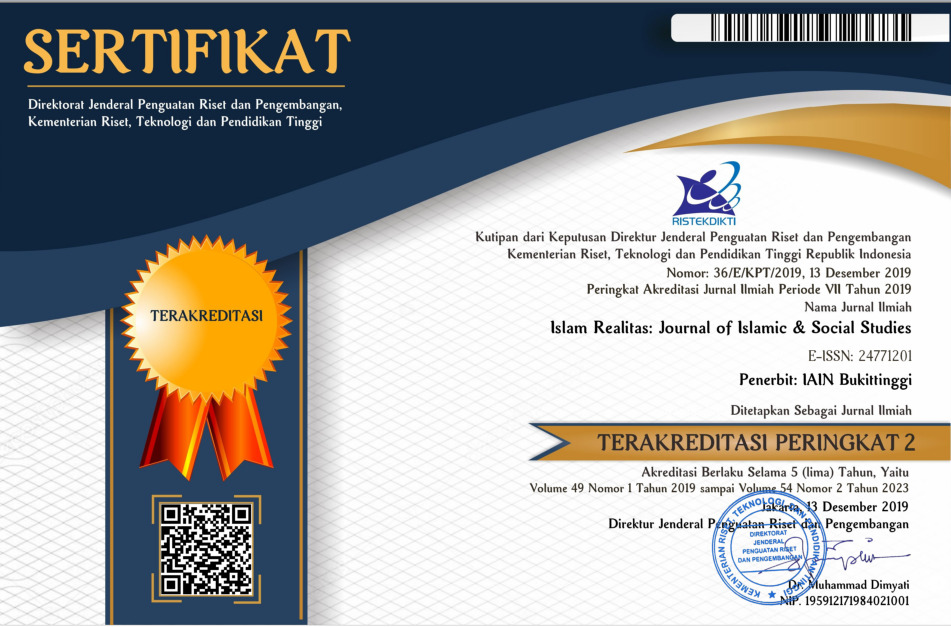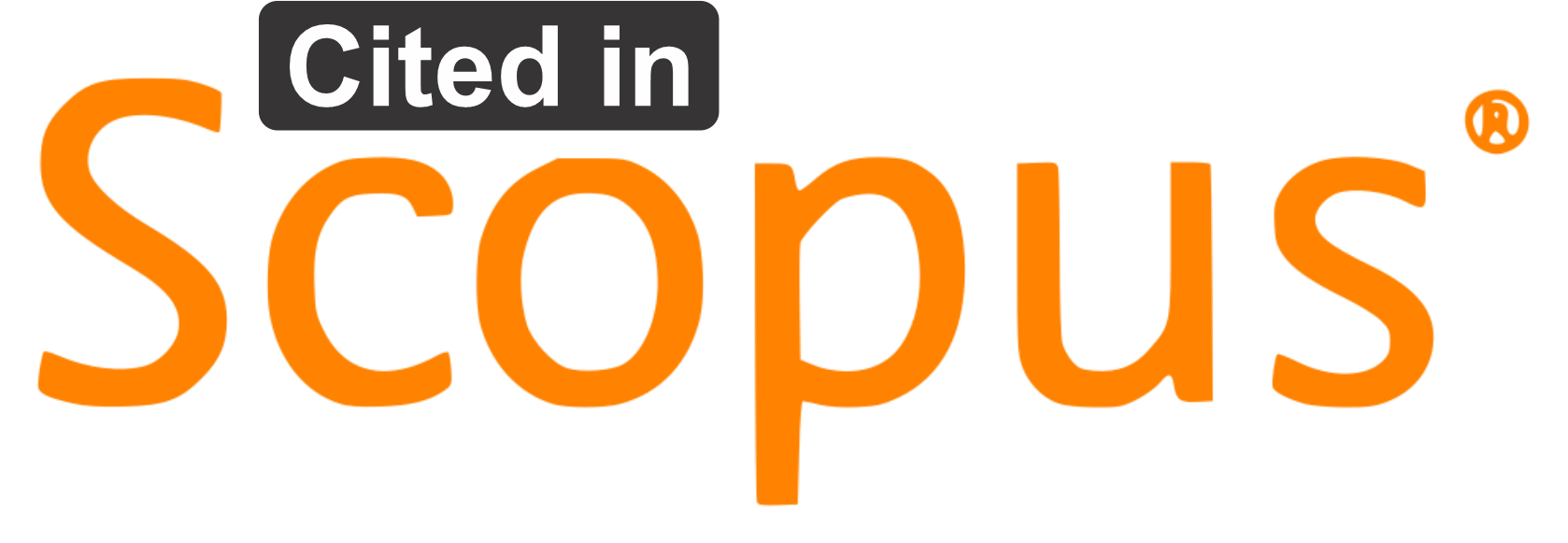CONTENT VALIDITY AND RELIABILITY ANALYSIS OF INTEGRATED ISLAMIC-SCIENCE TEST INSTRUMENT TO MEASURE THE STUDENT’S CRITICAL THINKING ABILITY
Downloads
Additional Files
This research is aimed to asses the validity and reliability of Islamic-science integrated test instrument. The instrument was formed in multiple-choice test instrument which is regarded as appropriate to assist student critical thinking ability. The validity of the instrument and its reliability were assessed quantitively. While Aiken’s V was used for assessing content validity, and Alpa Cronbach was used for assessing content reliability. In terms of Item Response Theory, it was assessed through the test I Function information and Standard Error of Measurement (SEM). The result of developing Islamic-science integrated test instrument to measure critical thinking ability was formed in the form of closed-minded multiple choice that consisting of two test packages. The total test items on the instrument are 45 items consisting of 25 items with 5 shared items (anchor). Estimation of the validity test instrument obtained an index ranging from 0.75 to 1. According to classical test theory, the coefficient of reliability was 0.70 and according to the total function information and Standart Error of Measurement, the test instrument was suitable for rangeability from 1.75 to +3. Thus, the test instrument is proved reliable and valid. A total of seven teachers using the declared that the test instrument is appropriate to use in measuring learning outcomes, especially the critical thinking abilities of the student
Â
Penelitian ini bertujuan untuk menganalisis konten validitas dan reliabilitas dari intrumen tes terintegrasi agama dan sains. Konten validitas dan reliabilitas dianalisis secara kuantitatif. Pendekatan kuantitatif untuk konten validitas menggunakan Aiken’s V, sedangkan untuk konten reliabilitas menggunakan Alpha Cronbach dan secara teori respon butir menggunakan fungsi informasi dan kesalahan pengukuran. Hasil pengembangan berupa instrumen tes terintegrasi agama dan sains untuk mengukur kemampuan berpikir kritis berupa tes pilihan ganda beralasan tertutup yang terdiri atas dua paket tes. Total item tes pada instrumen sebanyak 45 item yang terdiri dari 25 item dengan 5 item bersama (anchor). Estimasi validitas instrumen tes menggunakan formula Aiken diperoleh rentang indeks antara 0,75 sampai 1. Estimasi reliabilitas tes menurut teori tes klasik ditunjukkan oleh koefisien Alpha Cronbach sebesar 0,70 dan menurut kurva total fungsi informasi dan SEM yang berdasar pada teori respon butir (IRT) instrumen tes cocok untuk rentang kemampuan -1,75 sampai +3. Dengan demikian instrumen tes terbukti valid dan reliabel. Sejumlah tujuh guru pengguna instrumen tes menyatakan bahwa instrumen tes layak digunakan dalam pembelajaran. Dengan demikian instrumen tes cocok dan layak digunakan untuk mengukur hasil pembelajaran khususnya pada kemampuan berpikir kritis peserta didik.
Books
Anderson, L.W., D. R, Krathwohl, Kerangka Landasan untuk Pembelajaran, Pengajaran, dan Asesmen (Revisi Taksonomi Pendidikan Bloom), cetakan kedua (terjemahan Agung Prihantoro) (Yogyakarta: Pustaka Pelajar, 2017)
Azwar, S., Constructing Psychological Scale (Yogyakarta: Pustaka Pelajar, 2017)
--------, Konstruksi Tes Kemampuan Kognitif, edisi kesatu (Yogyakarta: Pustaka Pelajar, (2016)
Hair, J.F., et.al., Multivariate Data Analysis 7th Edition (New York: Pearson Prentice Hall, 2010)
Mardapi, Djemari, Pengukuran, Penilaian dan Evaluasi Pendidikan (Yogyakarta: Parama Publishing, 2016)
Retnawati, H., Validitas, Reliabilitas, dan Karakteristik Butir: Panduan Untuk Peneliti, Mahasiswa, dan Psikometrian (Yogyakarta: Parama Publishing, 2016), p. 16.
Subali, B., Pengembangan Tes: Beserta Penyelidikan Validitas dan Reliabilitas Secara Empiris (Yogyakarta: UNY Press, 2016)
Suryabrata, S., Pengembangan Alat Ukur Psikologi (Edisi Ketiga) (Yogyakarta: Penerbit Andi, 2005)
Team Publish, Salinan Undang- Undang No. 20 Tahun 2003 tentang Sistem Pendidikan Nasional (Jakarta: Nusa Press, 2017)
Wagner, T., The Global Achievment Gap (New York: Basic Book, 2008)
Wells, Craig S., James A. Wollack, An Instructor’s Guide to Understanding Test Reliability: Testing & Evaluation Services (UK: University of Wisconsin, 2003)
Widoyoko, E.P., Teknik Penyusunan Instrumen Penelitian (Yogyakarta: Pustaka Pelajar, 2016)
Journals
Aiken, Lewis R., ‘Three Coefficients for Analyzing the Reliability and Validity of Ratings’, Educational and Psychological Measurement, 45 (1985), 131–42 <https://doi.org/10.1177/0013164485451012>
Hudha, Safa’at Ariful, and Djemari Mardapi, ‘Developing an Instrument for Measuring the Spiritual Attitude of High School Students’, Research and Evaluation in Education, 4 (2018), 35–44 <https://doi.org/10.21831/reid.v4i1.20304>
Istianah, Euis, ‘Meningkatkan Kemampuan Berpikir Kritis dan Kreatif Matematik dengan Pendekatan Model Eliciting Activities (MEAS) pada Siswa SMA’, Infinity Journal, 2 (2013), 43 <https://doi.org/10.22460/infinity.v2i1.23>
Istiyono, Edi, Djemari Mardapi, and Suparno Suparno, ‘Pengembangan Tes Kemampuan Berpikir Tingkat Tinggi Fisika (PysTHOTS) Peserta Didik SMA’, Jurnal Penelitian dan Evaluasi Pendidikan, 18 (2014), 1–12 <https://doi.org/10.21831/pep.v18i1.2120>
James Dean Brown, ‘The Cronbach Alpha Reliability Estimate’, Shiken: JALT Testing & Evaluation SIG Newsletter, 6 (2002), 17–18
Kunter, Mareike, Uta Klusmann, Jürgen Baumert, Dirk Richter, Thamar Voss, and Axinja Hachfeld, ‘Professional Competence of Teachers: Effects on Instructional Quality and Student Development’, Journal of Educational Psychology, 105 (2013), 805–20 <https://doi.org/10.1037/a0032583>
Mumtahanah, Nurotun, ‘Meningkatkan Kemampuan Berpikir Kritis Siswa Melalui Metode Cooperative Learning dalam Pembelajaran PAI’, Al Hikmah: Jurnal Studi Keislaman, 3 (2013), 4
Pradana, Shan Duta Sukma, Parno Parno, and Supriyono Koes Handayanto, ‘Pengembangan Tes Kemampuan Berpikir Kritis pada Materi Optik Geometri untuk Mahasiswa Fisika’, Jurnal Penelitian dan Evaluasi Pendidikan, 21 (2017), 51 <https://doi.org/10.21831/pep.v21i1.13139>
Quitadamo, Ian, Celia Faiola, James E. Johnson, and Martha J. Kurtz, ‘Community-Based Inquiry Improves Critical Thinking in General Education Biology’, CBE Life Sciences Education, 7 (2008), 327–37 <https://doi.org/10.1187/cbe.07-11-0097>
Suwarto, S, ‘Pengembangan Tes Ilmu Pengetahuan Alam Terkomputerisasi’, Jurnal Penelitian dan Evaluasi Pendidikan, 21 (2017), 153 <https://doi.org/10.21831/pep.v21i2.13144>
Yaghmaie, F, ‘Content Validity and Its Estimation’, Journal of Medical Education, 3 (2003), 25–27 <https://doi.org/10.22037/jme.v3i1.870>
Yusup, Febrinawati, ‘Uji Validitas dan Reliabilitas Instrumen Penelitian Kuantitatif’, Jurnal Tarbiyah : Jurnal Ilmiah Kependidikan, 7 (2018), 32–45 <https://doi.org/10.18592/tarbiyah.v7i1.2100>
Other references
Hove, G., ‘Developing Critical Thinking Skills in The High School English Classroom’ {unpublished magister thesis, University of Wisconsin-Stout, 2011}
Widiarso, W., ‘Aplikasi Teori Respon Item untuk Pemodelan Respons Menipu pada Skala Kepribadian’ {unpublished research report, Fakultas Psikologi UGM, Yogyakarta. 2010}
Yusri, ‘Keterkaitan Scientific Learning dengan Kemampuan Berpikir Kritis (Kajian Proses Pembelajaran di Sekolah Dasar Budi Mulia Dua Sedayu Bantul)’ {unpublished magister thesis, Program Pascasarjana UIN Sunan Kalijaga, Yogyakarta, 2015}
Authors who publish with this journal agree to the following terms:
- Authors retain copyright and grant the journal right of first publication with the work simultaneously licensed under a Creative Commons Attribution License that allows others to share the work with an acknowledgment of the work's authorship and initial publication in this journal.
- Authors are able to enter into separate, additional contractual arrangements for the non-exclusive distribution of the journal's published version of the work (e.g., post it to an institutional repository or publish it in a book), with an acknowledgment of its initial publication in this journal.
- Authors are permitted and encouraged to post their work online (e.g., in institutional repositories or on their website) prior to and during the submission process, as it can lead to productive exchanges, as well as earlier and greater citation of published work (See The Effect of Open Access).









